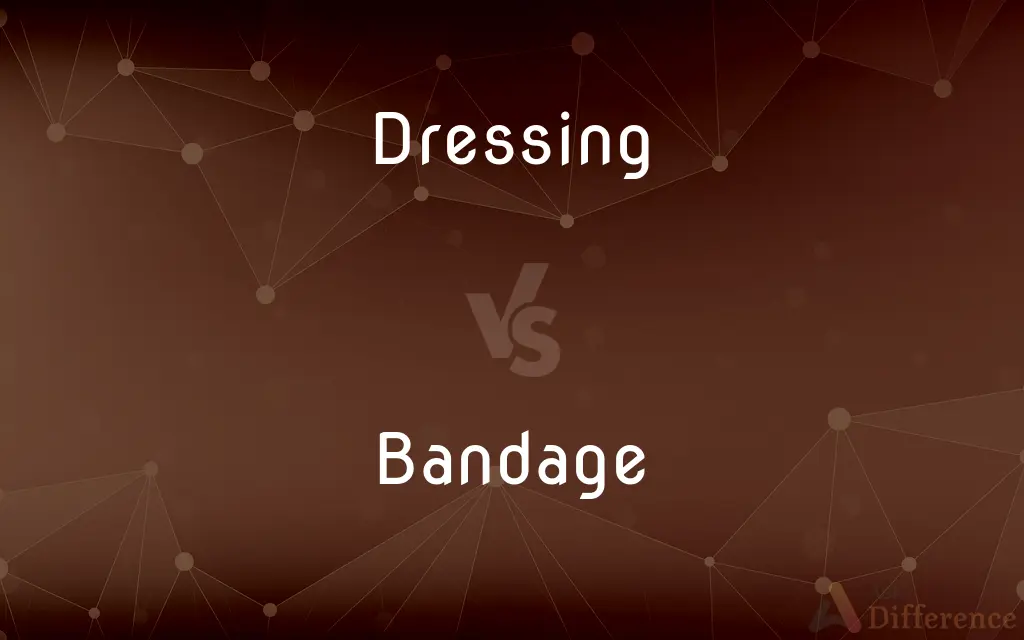Dressing vs. Bandage — What's the Difference?
By Tayyaba Rehman & Maham Liaqat — Updated on April 17, 2024
Dressing is a material applied directly to a wound to control bleeding and prevent infection, whereas bandage is used to hold a dressing in place or support an injured body part.

Difference Between Dressing and Bandage
Table of Contents
ADVERTISEMENT
Key Differences
A dressing is designed to be in direct contact with the wound, providing a protective and sometimes medicated layer to facilitate healing, whereas a bandage is primarily used to secure the dressing to the wound and ensure it stays in place.
Dressings are often impregnated with antiseptic solutions or other medications to aid in healing and reduce infection risk, whereas bandages are typically made of more flexible, sterile materials such as gauze or elastic fabric that do not have intrinsic therapeutic properties.
The primary function of a dressing is to absorb exudate, cover the wound, and create an optimal environment for healing, while bandages provide structural support and restrict the movement of the injured area to prevent further damage.
Specialized dressings such as hydrocolloids, foams, and alginates are available depending on the wound type and stage of healing, whereas bandages come in various types such as adhesive, cohesive, tubular, and triangular, each suited for different support and application needs.
Dressings require changing less frequently depending on the wound condition and type of dressing used, whereas bandages may need to be adjusted or replaced more often to maintain proper pressure and placement.
ADVERTISEMENT
Comparison Chart
Primary Purpose
Protect and heal the wound
Secure dressings, support injured part
Material Types
Gauze, foam, hydrocolloid, alginate, medicated
Gauze, elastic, crepe, adhesive
Functionality
Absorb exudate, prevent infection
Provide compression, support, and fixation
Frequency of Change
Depends on wound and dressing type
Often adjusted for comfort and effectiveness
Therapeutic Properties
Often medicated or specialized for healing
Generally non-medicated
Compare with Definitions
Dressing
A sterile pad or compress applied to a wound to promote healing and protect from further harm.
The nurse applied a medicated dressing to the burn to help prevent infection.
Bandage
A strip of cloth or other material applied to protect or compress a part of the body.
She secured the bandage over the dressing.
Dressing
A therapeutic application intended to shield a wound from infection and debris.
The dressing must remain dry to be effective.
Bandage
A strip of material wrapped around a body part, usually to hold a dressing in place or immobilize joints.
He used an elastic bandage to wrap the sprained ankle.
Dressing
Any material used to cover a wound that directly aids treatment.
Hydrocolloid dressings are perfect for managing blisters.
Bandage
Any material used to support muscles or bones.
The bandage must be elastic enough to allow some movement.
Dressing
A protective covering for a wound, often containing medicinal substances.
She changed the dressing daily to keep the wound clean.
Bandage
A binding material used for support or compression.
The nurse wrapped the bandage tightly to stop the bleeding.
Dressing
A component of wound care that absorbs exudate.
The dressing was saturated and needed to be changed.
Bandage
An aid in wound care or injury management.
The triangular bandage can be used as a sling for arm injuries.
Dressing
A sauce for salads, typically one consisting of oil and vinegar with herbs or other flavourings
Sprinkle each salad lightly with dressing
Vinaigrette dressing
Bandage
A bandage is a piece of material used either to support a medical device such as a dressing or splint, or on its own to provide support to or to restrict the movement of a part of the body. When used with a dressing, the dressing is applied directly on a wound, and a bandage used to hold the dressing in place.
Dressing
A piece of material used to cover and protect a wound
An antiseptic dressing
Bandage
A strip of woven material used to bind up a wound or to protect an injured part of the body
A strip of bandage
Her leg was swathed in bandages
Dressing
Size or stiffening used in the finishing of fabrics
Fabrics finished with dressing will work successfully when cut an inch wide
Bandage
Bind (a wound or a part of the body) with a protective strip of material
Bandage the foot so that the ankle is supported
Dressing
A therapeutic or protective material applied to a wound.
Bandage
A strip of material such as gauze used to protect, immobilize, compress, or support a wound or injured body part.
Dressing
A sauce for certain dishes, such as salads.
Bandage
To apply a bandage to.
Dressing
A stuffing, as for poultry or fish.
Bandage
A strip of gauze or similar material used to protect or support a wound or injury.
Dressing
Manure or other fertilizing material for soil.
Bandage
A strip of cloth bound round the head and eyes as a blindfold.
Dressing
(medicine) Material applied to a wound for protection or therapy.
Bandage
A provisional or makeshift solution that provides insufficient coverage or relief.
This new healthcare proposal merely applies a bandage to the current medical crisis
Dressing
(cooking) A sauce, especially a cold one for salads.
Bandage
To apply a bandage to something.
Dressing
Something added to the soil as a fertilizer etc.
Bandage
A fillet or strip of woven material, used in dressing and binding up wounds, etc.
Dressing
The activity of getting dressed.
Bandage
Something resembling a bandage; that which is bound over or round something to cover, strengthen, or compress it; a ligature.
Zeal too had a place among the rest, with a bandage over her eyes.
Dressing
(obsolete) Dress; raiment; especially, ornamental habiliment or attire.
Bandage
To bind, dress, or cover, with a bandage; as, to bandage the eyes.
Dressing
The stuffing of fowls, pigs, etc.
Bandage
A piece of soft material that covers and protects an injured part of the body
Dressing
Gum, starch, etc., used in stiffening or finishing silk, linen, and other fabrics.
Bandage
Wrap around with something so as to cover or enclose
Dressing
An ornamental finish, such as a moulding around doors, windows, or on a ceiling.
Bandage
Dress by covering or binding;
The nurse bandaged a sprained ankle
Bandage an incision
Dressing
(dated) Castigation; scolding; a dressing down.
Dressing
(dated) The process of extracting metals or other valuable components from minerals.
Dressing
Present participle of dress
Dressing
Dress; raiment; especially, ornamental habiliment or attire.
Dressing
An application (a remedy, bandage, etc.) to cover a sore or wound.
Dressing
Manure or compost over land. When it remains on the surface, it is called a top-dressing.
Dressing
A preparation, such as a sauce, to flavor food for eating; a condiment; as, a dressing for salad.
Dressing
Gum, starch, and the like, used in stiffening or finishing silk, linen, and other fabrics.
Dressing
An ornamental finish, as a molding around doors, windows, or on a ceiling, etc.
Dressing
Castigation; scolding; - often with down.
Dressing
Savory dressings for salads; basically of two kinds: either the thin French or vinaigrette type or the creamy mayonnaise type
Dressing
A mixture of seasoned ingredients used to stuff meats and vegetables
Dressing
Making fertile as by applying fertilizer or manure
Dressing
A cloth covering for a wound or sore
Dressing
Processes in the conversion of rough hides into leather
Dressing
The activity of getting dressed; putting on clothes
Dressing
The act of applying a bandage
Common Curiosities
Can any material be used as a bandage in emergencies?
In emergencies, clean cloths, scarves, or even pieces of clothing can be used as makeshift bandages, but sterile materials are preferred when available.
What are hydrocolloid dressings used for?
Hydrocolloid dressings are used for moist wound healing and are particularly effective for burns, ulcers, and necrotic wounds.
What are the signs that a dressing needs to be changed?
A dressing should be changed if it becomes wet, dirty, or saturated with exudate, or if there's an odor indicating possible infection.
How does one choose the right size of bandage?
Choose a bandage size that adequately covers the dressing and overlaps slightly to ensure secure placement without causing constriction.
Are there any natural alternatives to commercial dressings?
Natural alternatives like honey, aloe vera, or coconut oil dressings can be used for minor wounds, but they should be used with caution and under medical advice for serious injuries.
Can bandages be waterproof?
Yes, there are waterproof bandages available that protect the wound from moisture and allow for bathing and swimming.
Is it safe to use tape to secure a bandage?
Yes, medical tape is commonly used to secure bandages, but care must be taken to avoid skin irritation or allergy to adhesive materials.
What is the best way to remove a bandage?
The best way to remove a bandage is slowly and gently, ideally after softening any adhesive with a bit of medical alcohol or warm water to reduce discomfort.
How tight should a bandage be wrapped?
A bandage should be wrapped firmly to support the area without being so tight that it cuts off circulation.
What types of wounds require an antimicrobial dressing?
Wounds that are at high risk of infection, such as diabetic foot ulcers, or wounds that are already infected, may benefit from antimicrobial dressings.
Can dressings be reused after being removed?
Dressings should never be reused as this can introduce bacteria to the wound and increase the risk of infection.
How do I apply a bandage to a joint like an elbow or knee?
When bandaging a joint, ensure that the bandage is flexible enough to allow for movement without slipping. Use a figure-eight wrapping technique to provide stability.
What are some common mistakes when applying a dressing?
Common mistakes include using a dressing that is too small, not securing it properly, or failing to change it when necessary, leading to increased risk of infection.
What is the purpose of a triangular bandage?
A triangular bandage is versatile and can be used as a sling, to wrap wounds, or to immobilize limbs in the case of fractures.
Share Your Discovery

Previous Comparison
Enigma vs. Paradox
Next Comparison
Tenacity vs. ResilienceAuthor Spotlight
Written by
Tayyaba RehmanTayyaba Rehman is a distinguished writer, currently serving as a primary contributor to askdifference.com. As a researcher in semantics and etymology, Tayyaba's passion for the complexity of languages and their distinctions has found a perfect home on the platform. Tayyaba delves into the intricacies of language, distinguishing between commonly confused words and phrases, thereby providing clarity for readers worldwide.
Co-written by
Maham Liaqat














































